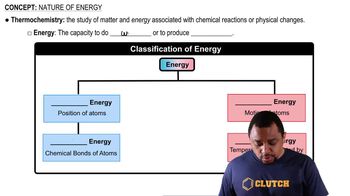Here are the essential concepts you must grasp in order to answer the question correctly.
Combustion Reaction
A combustion reaction is a chemical process in which a substance reacts with oxygen to produce heat and light. Typically, hydrocarbons combust to form carbon dioxide and water. The amount of energy released during combustion depends on the structure of the hydrocarbon and the number of carbon and hydrogen atoms present.
Recommended video:
Stoichiometry
Stoichiometry is the calculation of reactants and products in chemical reactions based on the balanced chemical equation. It allows us to determine the moles of products formed from a given amount of reactants. In this case, knowing the stoichiometric coefficients for the combustion of each hydrocarbon will help us compare the total moles of carbon dioxide produced.
Recommended video:
Energy Content of Fuels
The energy content of fuels, often measured in kilojoules per mole, indicates how much energy is released during combustion. Different hydrocarbons have varying energy contents based on their molecular structure. By comparing the energy released per mole of each compound during combustion, we can determine which fuel produces the least energy and, consequently, the least amount of products.
Recommended video:





